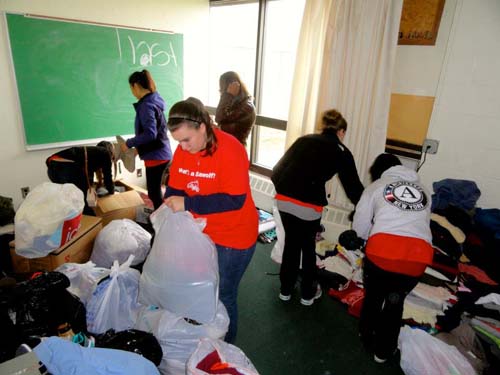Long Beach, Long Island’s own surf city, is now battered and beaten because of Superstorm Sandy.
It is the home of Stony Brook senior Nate Epstein. For the past three weeks, the philosophy major has been living in his flooded house with no heat or clean water. He returned to school over a week after classes resumed because he was finally allowed to leave the barrier island for the first time since the storm hit. His car was totaled and the furniture on the first floor of his house completely ruined. Epstein watched his hometown transform from a city with a West Coast atmosphere to one that looks like it belongs in a warzone.
“It literally looks like Baghdad,” he says, referring to huge sand piles washed onto the streets from the beach. “It’s crazy.”
But relief efforts in Long Beach have been extensive, as they’ve been throughout Long Island and New York City. Organizations such as FEMA, the National Guard and the Red Cross have been providing clothing, food and other services to thousands of victims in some of the hardest hit cities in the tri-state area. Here at Stony Brook, students have taken the initiative of starting their own relief efforts and participating in others. Over the last three weeks, clubs, Greek organizations and other student-run groups have been gathering the campus together for donations, some raising over $700 and obtaining several boxes of supplies in the process.“We are the best people to give back,” says junior Summer Broeckx-Smith, the philanthropy chair for Alpha Sigma Alpha.
Spearheading one particular relief effort is Staten Island resident and Stony Brook senior Rob Wranovics. Although his house was not damaged, the borough as a whole saw some of the worst devastation in New York City, including the highest death toll. Wranovics, the student sports director at WUSB and host of the station’s show “Hectic Electric,” rallied a large group of students together for a Nov. 6 fundraiser with his “Seawolves for Sandy Relief” Facebook page. He says that experiencing such tragedy so close to home inspired him to reach out and help his neighbors, along with the rest of the hurricane victims.“You got to remember who you are and where you come from,” he says. “It can happen to any of us at any time. It’s a very moving situation.” Wranovics says the relief on campus went off to a promising start—donations poured in at his event. Laptops set up at tables allowed for immediate contributions to the Red Cross, and physical monetary donations were sent out shortly after. The students set up charging stations for those who still did not have power restored back to their homes. And in addition to money, the fundraiser brought in donations of toiletries, batteries, cell phones and even a comforter, all of which Wranovics personally drove out to Staten Island.
Actually going to Staten Island opened Wranovics’ eyes to how much people there are struggling to get back on their feet. As he took in the damage, he handed out supplies: the comforter went to a family he saw on the streets; he gave garbage bags to a woman living out of her car; and an elderly couple with no power in their home received flashlights.
“They were so thankful,” Wranovics says. “It was really touching.” But the relief efforts on campus didn’t stop after that fundraiser. Broeckx-Smith, who says she felt obligated to help out after seeing the damage done to Stony Brook the day after the hurricane, has been tabling in the Student Activities Center and leading “dorm storms” with her Alpha Sigma Alpha sisters. The sorority is focusing on raising money for Save the Children’s Sandy relief fund, as its philanthropy aims towards helping out youth, she says. Other parts of the campus such as health sciences, campus residences and the Career Center have taken part in the relief effort as well. Urszula Zalewski, project director for Stony Brook AmeriCorps and assistant director of experiential programs at the Career Center, says the center collaborated with Long Island Volunteer Center, Long Island Cares and other organizations by providing them with student volunteers. On Nov. 3, students worked in the food distribution center at Island Harvest in Mineola. And over 50 participated in relief efforts at Mastic Beach Nov. 10. In total, about 600 students expressed interest in aiding Sandy victims through the Career Center, Zalewski says.
“We were overwhelmed with students who wanted to help,” she says. “It was amazing to see how many wanted to go out to the community. It was very impressive.”
Superstorm Sandy battered the East Coast: it brought on unprecedented storm surges, millions of dollars in damages and left a massive mess for New Yorkers to clean up. According to CBS, a total of 48 deaths were reported in the state. About 2.2 million were left without power. Thousands of people lost homes in Rockaway, Staten Island, Long Beach and elsewhere.
And because of that, students heading relief efforts predict that they will continue for weeks.
“This isn’t going to go away for a little while,” Wranovics says. “It may disappear from the news, but it’s not going away.”
For students such as Nate Epstein who experienced the wrath of Sandy firsthand, the support from his fellow Seawolves is appreciated, especially because many students were fortunate not to see damage to their homes.
“It’s really cool when you see someone who hasn’t been affected lend a helping hand to their neighbors,” he says.
But Epstein says that even though Sandy has probably left a permanent mark on Long Beach, the city will eventually rebuild itself and move on, as he and his family have begun to do.
“Life goes on. Everyone’s okay.”


